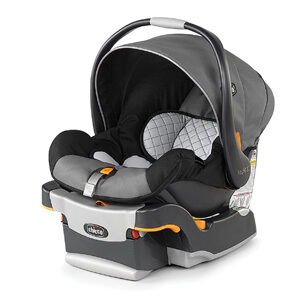Chicco KeyFit 30
Face Rear
- Weight range (lb): 4-30 (RF)
- Height limits: 30" (RF)
- Stage: 1st
- Lifespan: 6 years
On the hunt for an infant car seat that best fits premature babies? Look no further, the Chicco KeyFit 30 is a well-rounded model primed to deliver a high-quality riding experience. Featuring a weight range between 4 to 30 pounds and a top height up to 32 inches, it’s the perfect companion for newborns and infants.
And it doesn’t stop there, touted as one of the safest child restraints in its class, the KeyFit 30 benefits from various safety features. Plus, parents will be pleased to hear that it’s 9.5-pound lightweight and compatible with all Chicco strollers, making it more portable to switch from car seat model to stroller. From safety to style, the KeyFit 30 has it all.
Its SuperCinch tightener, ReclineSure leveling foot, and RideRight bubble indicator ensure proper and comfortable installation whilst its stylish and fashionable large canopy.
Chicco KeyFit 30 Car Seat Review - Best for Preemies
Pros & Cons
The good and the bad
What is it best for
Who we recommend it for
Value for Money
Is it worth the price tag?
Design
Dimensions, weight, color, etc
Safety Rating
Crash tests, FMVSS213, SIP
Performance
Weight/height limits, airplane, etc
Installation
Install with LATCH or seat belt
Alternatives
Other car seats to consider
1. Pros and Cons
Pros
- Lightweight for carrying and switching
- Most popular for preemie
- Large and removable canopy
Cons
- A bit pricey
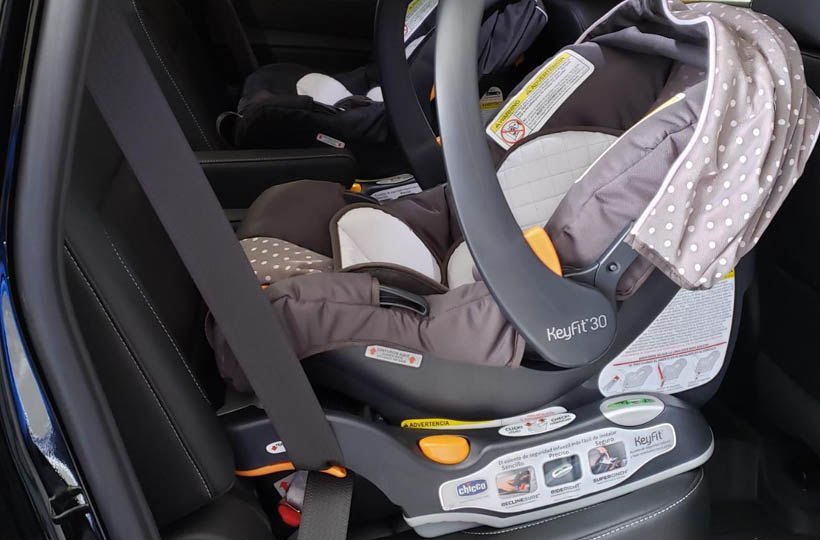
2. Who Is It Best For?
Will the Chicco KeyFit 30 be a good option for your child and your family?
The KeyFit 30 has proved itself to suit newborn needs with safety and comfort. It’s a good infant car seat and great for those new parents who have their first baby.
While it boasts a low-bottom weight limit that is friendly for preemies to be better than a lot of its competitors, the Chicco KeyFit30 isn’t the only car seat with a 4-pound lowest rear-facing weight limit.
If you’re going to find an alternative for different purposes, the Doona Infant car seat will be the only one with four wheels, and Graco 4Ever DLX is the best money saver by riding your child through three cars seat stages.
Ultimately, if you are taking your first steps into the world of child safety seats and don’t want to settle for a model that your baby will outgrow within a few months but also don’t want to dive into the deep end – and build your confidence before upgrading to a more functional high-performance model – the Chicco KeyFit 30 is the ideal infant car seat.
3. Value for Money
Is the price tag worth it?
So you wanna know if it’s worth splashing out on the Chicco KeyFit 30? In short, it’s worth it.
For a price of around $200, it’s a reasonably priced infant car seat, especially when you take into consideration that it is one of the most popular models.
Not only does it satisfy those parents with a premature newborn, but it’s also been built with high-quality materials and clever technologies that ensure it rides safely and comfortably.
Take the SuperCinch, for example. It’s very helpful in the rush status for parents. This one-time tightener makes it easy for parents to tighten the 5-point harness in a short time.
You just need to check if the strap is tight enough by putting one finger between the harness strap and your baby.
When you consider the longevity offered by the KeyFit 30 and the fact that it’s less expensive than plenty of other premium child restraint systems, it is the gift that keeps on giving.
However, it is worth noting that for all the KeyFit 30 has to offer, other infant car seats rival it for value. The main ones which you can see in the ‘Alternatives’ section below.
4. Design
Dimension and Width
The Chicco KeyFit 30 is a compact infant car seat. It measures at 16.75” (width) x 24” (height) x 27.5” (depth).
The 16.75-inch width is very skinny. It’s the narrowest compared to its main competitors listed above This slim width makes the Chicco KeyFit 30 fit 3 across if you have to install three child safety seats in the back seat.
It’s even narrower than the 17-inch of Diono Radian 3R, which boasts of its 3-across fitting. It’s understandable that the Chicco KeyFit 30 features such a slender body. Parents often need to take it in and out of the car. A compact and slim body makes it easy for parents to carry it anyway.
The depth up to 27.5 inches is a drawback to Chicco KeyFit 30. After installing it in the back seat, either behind the driver or the front passenger’s seat, it will take up a little space from the front row.
That seems to be the common problem for all infant car seats or any child safety seats that are installed facing the back.
Portability
Just like most infant car seats, the Chicco KeyFit 30 gets a high score in the portability – up to 8.5, for its lightweight and slim body.
It weighs only 9.5 pounds, without the base, of course. That’s really a big improvement compared to those heavy convertible car seats or combination child restraints.
This matches its purpose – keep the newborns and small babies in this place in the car seat or take him/her wherever you go by placing the car seat on a stroller.
However, Chicco KeyFit 30 is not the one that earns the highest score in the portability – Doona infant car seat almost gets the full score – 9.5 out of 10, for its folding design and four big wheels to turn into a stroller.
Head Rest Insert
Infant car seats do not have an adjustable headrest like other car seat types, because they suit newborn babies and small toddlers who grow a bit slower at that time.
However, the headrest insert is included in Chicco KeyFit 30 to give your baby extra support for safety and comfort.
The Head Rest Insert can be used with or without the newborn positioner.
to install the headrest insert, thread the headrest straps through the harness strap adjustment slots on the seatback. attach headrest hook and loop straps together.
Newborn Positioner
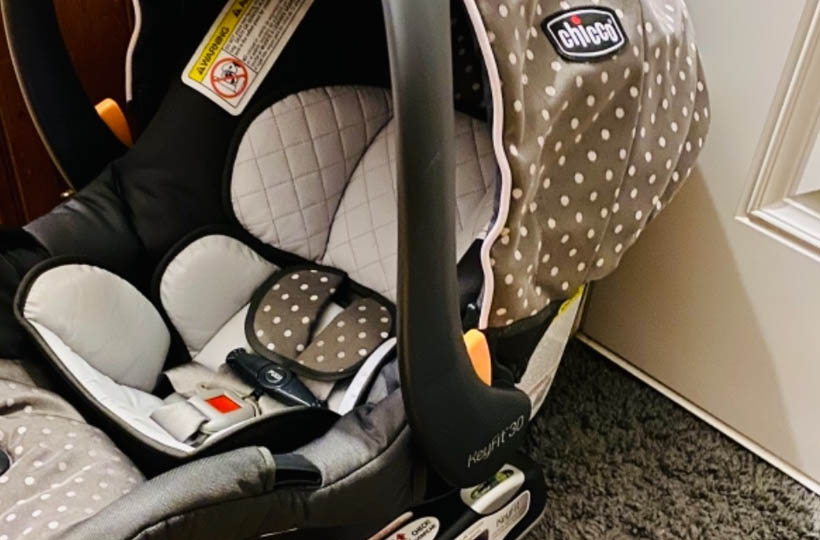
You’ll find a newbor positioner is included in the Chicco KeyFit 30 package. It is suited for small infants weighing between 4 and 11 pounds, ensuring a better fit for these smaller infants.
Follow the steps to use the newborn positioner to accommodate your baby.
1. Place the newborn positioner in the carrier seat, then pull the buckle through the slot in the bottom of the newborn positioner.
2. Pull both harness straps over the side panels of the newborn positioner.
3. Push the newborn positioner firmly into the carrier to make sure it is properly positioned against the back of the seating area.
Harness
The 5-point harness is essential to protect your baby and it can be tightened with only one hand for a snug fit with less effort.
How to adjust harness height for best accommodation?
1. With the child seated correctly in the Carrier, resting against the back and bottom of the carrier and not slouched, locate the Harness Strap Adjustment Slot closest to AT or JUST BELOW top of the child’s shoulders.
2. Remove your child from the carrier and loosen the Harness Straps. Turn the Carrier over and locate the splitter plate. Unhook one Harness Strap from the Splitter Plate.
3. Pull the Harness Strap out through the front of the Carrier. Then re-thread the Harness Strap through the desired Harness Strap Adjustment Slot.
4. Re-attach Harness Strap to the Splitter Plate. Repeat steps 1-4 of Adjusting Harness Height for the other Harness Strap. Make sure both Harness Straps are positioned at the same height, as shown.
Canopy
The Chicco KeyFit 30 comes with a large canopy that is great to protect your baby from sunshine or raindrops.
It’s removable or adjustable when installed in your vehicle.
Adjusting Canopy: The Canopy can be adjusted by rotating the canopy forwards or backward.
Removing Canopy: Pull back the fabric and press the button on Canopy Mount and pull up to remove it. Repeat for the other side.
Attaching Canopy: Re-attach both of the Canopy Mounts into the slots on the side of the Carrier.
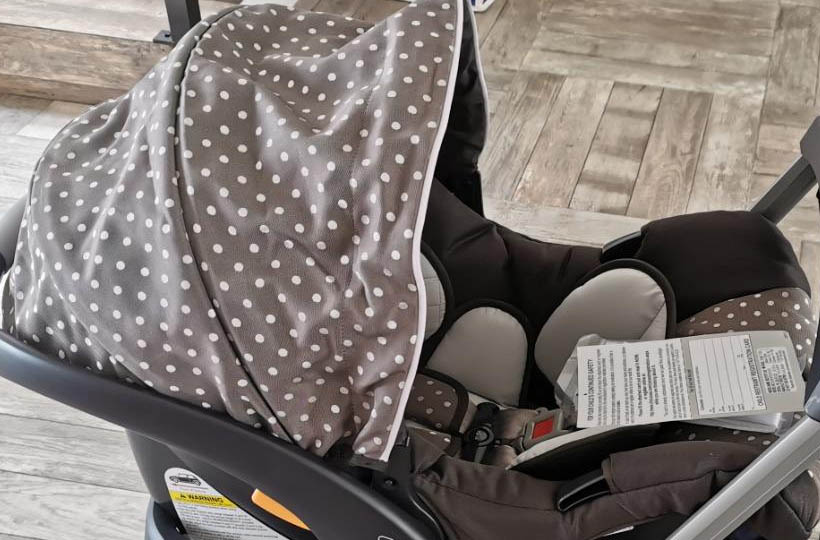
5. Crash Tests and Safety Ratings
Is it safe to ride with a Chicco KeyFit 30?
Unlike the premium models that apply the DuoGuard technology to protect big kids, as an infant car seat, the Chicco KeyFit 30 makes full use of its metallic carrier shell for safety and protection.
Tons of padding that is made of EPS energy-absorbing foam provide not just the extra impact protection but also the most comfort for newborns and infants younger than 1-year-old.
Moreover, thanks to the premium LATCH connectors, SuperCinch, ReclineSure, and RideRight bubble level indicators, they make the installation of Chicco KeyFit 30 the easiest and simplest, absolutely adding points to its safety performance. Proper installation ensures 90% safety.
6. Performance
Weight and Height Limits
The Chicco KeyFit 30 was designed for newborns and small infants. It comes with a minimum weight of 4 pounds, making it good for preemies. The top weight is up to 30 pounds, which is 5-pound less than most infant car seats.
That means a short usage time, and we’ll talk about it in the age range section in the next.
The same case happens to the height limit.
As its name indicates, the Chicco KeyFit 30 comes with a 30-inch height limit. That is 2-inch less than other infant car seats like Doona, UPPABaby MESA, and Graco SnugRide SnugLock 35.
Age Range/Longevity
As an infant car seat that features a 30-pound top weight and a 30-inch top height, the Chicco KeyFit 30 is predictable for short usage time for a baby, even if it features a 6-year lifespan.
With its 30-lb-inch combination weight and height limits, it’s suited for most infants that are less than 1 year old, or even just for 9-month infants if they’re a bit bigger than their peers.
This is really a drawback for KeyFit 30, as most US states indicate in their child restraint laws that infants and toddlers younger than 1-year-old should ride rear-facing.
But it might not last that long for those infants who grow a bit faster.
Stages
Infant car seats will last for only one stage – rear-facing which is also the first of four car seat stages. So does the Chicco KeyFit 30.
Fitting newborn babies is the only reason that the manufacturer developed this car seat.
Airplane
Is a Chicco KeyFit 30 infnat car seat allowed on planes?
Yes. The Chicco KeyFit 30 is approved for use in aircraft. With a lightweight body, the KeyFit 30 is suitable for both car and air travelers.
You can install the seat on an airplane the same way it is installed in a vehicle when using a lap belt because there is no shoulder belt on the aircraft seats – that’s the only reason toddler booster seats can’t be used on airplanes.
It’s important to know that the Chicco KeyFit 30 should be used only on forward-facing seats on the plane.
Further Information
Lifespan
How long is a Chicco KeyFit 30 good for?
The KeyFit 30 has a 6-year lifespan that is calculated from the manufacturer’s date.
You should pay attention to this date because it’s not the same day when you purchase the car seat. It should be earlier.
Generally, you can find the expiration label on the sticker at the bottom of the KeyFit 30.
The 6-year lifespan is not long, especially compared to convertible or combination car seats that have a long 10-year lifespan.
But it’s good enough to safely ride your child through infant time until they outgrow the car seat.
Further Information
Warranty
Very like other car seats, the Chicco KeyFit 30 comes with a one-year limited warranty.
To claim the warranty, you should provide necessary information like the purchase proof to their team.
It’s better to register the car seat the very first time when you receive it and confirm to keep it for riding your baby.
7. Chicco KeyFit 30 Installation
Which Installation Method Should I Use?
This car seat can be installed in your vehicle using either the vehicle seat belt or the LATCH system.
The base can be included or not included for installation.
Both ways are equally safe to ride your child as long as you install it properly following the Chicco KeyFit 30 user manual. It’s NOT allowed to use both methods at the same time.
Install Chicco KeyFit 30 with Base
Infants may have difficulty breathing when in a sitting position. Make sure the seat is reclined properly so that your child’s head does not fall forward. Failure to properly recline the Child Restraint could increase the child’s risk of serious injury or death.
1. See page 16 for “Vehicle Seating Positions” before installing. Make sure the vehicle is on a level surface. Place Base on selected vehicle seat. Make sure it is not blocking the vehicle seat belt buckle.
2. Locate the Bubble Level Indicator and adjust the Recline Foot by pushing in on both Foot Adjuster buttons and lifting or lowering the base until the Bubble falls between the arrows on the Bubble Level Indicator (2b) .
Install Chicco KeyFit 30 Using LATCH
Store LATCH Connectors properly in the compartments when not used for installation.
When installing with LATCH, the unused seat belt should not be buckled behind the Child Restraint System as this will engage the inflatable portion of the belt.
1. Pull up on the LATCH Release Lever and loosen the LATCH straps to their full length.
2. Locate the LATCH Connector storage compartments. Remove both LATCH Connectors.
3. Locate the LATCH anchor bars in your vehicle. Attach both LATCH Connectors to the vehicle LATCH anchor bars.
4. Tighten LATCH straps by pulling up on LATCH Pull Strap while pressing Base firmly into vehicle seat
5. Roll LATCH Pull Strap and store in Pull Strap Storage Slot, as shown.
Install Using Lap/Shoulder Belt With 5-Point Harness
1. Thread the vehicle seat belt up through the belt path on the side of the Base.
2. Pull the vehicle seat belt down through the vehicle seat belt path on the opposite side of the Base. Buckle the vehicle seat belt.
3. While pushing down on the Base, pull up on the vehicle shoulder belt to remove all slack from the vehicle lap belt.
4. While holding the shoulder belt tight, slide the shoulder belt strap firmly into Shoulder Belt Lock-Off. Always use the Lock-Off on the opposite side of where the vehicle seat belt is buckled.
****Do NOT pull on the shoulder belt after it is positioned in Lock-Off. This could damage the Lock-Off and/or the vehicle belt.
Install Using 5-Point Harness With Lap Belt
1. Thread vehicle seat belt up through the belt path on the side of the Base.
2. Pull vehicle seat belt down through the vehicle seat belt path on opposite side of the Base. Buckle the vehicle seat belt.
3. While pushing down on the Base, pull up on the loose end of the vehicle lap belt to remove all slack.
Install Carrier To Base
1. Insert the Carrier into the Base.
2. Push down on the Carrier to make sure it locks onto the Carrier Attachment Hooks on the Base.
3. Check to make sure the Carrier is securely attached to the Base.
Install Chicco KeyFit 30 without Base Setup
Install Using Lap-Shoulder Belt
1. Thread vehicle seat belt up and slide into the Seat Belt Guide on the side of the Child Restraint.
2. Pull vehicle seat belt down and slide into the Seat Belt Guide on opposite side of the Child Restraint. Buckle the vehicle seat belt. Pull out all of the shoulder belt webbing and activate the locking mode of the vehicle belt. If belt does not lock, do not use that seating position to install the carrier.
****Put the vehicle seat belt in the locked mode, see vehicle owner’s manual for more information. A tightly rolled towel may be used under the front edge of the Carrier if needed to adjust the angle of the Carrier. Angle is correct when level line on Carrier is level with ground.
3. While pushing down on the Carrier, pull up on the vehicle shoulder belt to remove all slack from vehicle lap belt.
Install Using Lap Belt Only
1. Thread vehicle seat belt up and slide into the Seat Belt Guide on the side of the Child Restraint.
2. Pull vehicle seat belt down and slide into the Seat Belt Guide on opposite side of the Child Restraint. Buckle the vehicle seat belt.
*** Put the vehicle seat belt in the locked mode, see vehicle owner’s manual for more information. A tightly rolled towel may be used under the front edge of the Carrier if needed to adjust the angle of the Carrier. Angle is correct when level line on Carrier is level with ground
3. While pushing down on the Child Restraint, pull up on the loose end of the vehicle lap belt to remove all slack.
Check Your Work
- Hold Child Restraint at each side and pull side to side and forward. Child Restraint should not move more than 1” (25 mm) from vehicle seat back or side-to-side.
- Make sure Child Restraint is level. Make sure infant’s head does not fall forward. If necessary re-adjust recline and repeat installation steps to make sure Child Restraint is installed properly.
- Check installation before every use!
Chicco KeyFit 30 Car Seat Manual
The car seat manual should go with the car seat in the package. It’s important for parents to read and follow the manual to use and maintain the car seat.
After all, it’s the official instructions and guides from the manufacturer, who know their product most.
The Chicco KeyFit 30 infant car seat manual can be also found online for easy access and viewing.
8. Specification and Comparison
Brand | |
Brand | Chicco |
Type | |
Suitable for | Newborns and infants |
Positions | Rear-facing |
Design | |
Portability (1-10) | 8.5. Lightweight and slim |
Weight (lb.) | 9.5 |
Weight limits (lb.) | 4-30 for rear-facing |
Height limit (inch) | 30” for rear-facing |
Dimension | 27.5″ x 16.75″ x 24″ |
Cup holder | No |
Performance | |
Age Range | 0-9 months old |
Stage | 1st |
Longevity | 0-9 months old |
Installation | LATCH and seat belt |
Headrest Positions | – |
Recline Positions | – |
Airplane | Yes |
Lifespan | 6 Years |
Extra Features | – |
Chicco KeyFit 30 vs KeyFit 30 Zip vs KeyFit 30 Zip Air
| Car Seats Comparison | Chicco KeyFit 30 | Chicco KeyFit 30 Zip | Chicco NextFit Zip Air |
|---|---|---|---|
| MSRP Price | $199.99 | $229.99 | $239.99 |
| Rear-Facing Weight Limit | 4-30 lbs | 4-30 lbs | 4-30 lbs |
| Rear-Facing Height Limit | 30 inches | 30 inches | 30 inches |
| Carrier Weight | 9.5 lb | 9.6 | 10 |
| SuperCinch LATCH | ✓ | ✓ | ✓ |
| Reversible Newborn Insert | - | - | ✓ |
| Convenient Zip Features | - | ✓ | ✓ |
| 3D Air Mesh | - | ✓ | ✓ |
| Removable Boot | - | ✓ | ✓ |
9. FAQs on Chicco KeyFit 30 Infant Car Seat
The Chicco KeyFit 30 Infant Car Seat will not be your forever car seat. Its recommended use is from 4 pounds (using the newborn insert) to 30 pounds, or 30 inches—whichever comes first.
In terms of lifespan, the Chicco last as long as 6 years from its manufacturer date.
Yes. The manufacturer boasts that it’s the #1 of top-rated infant car seats.
Consumer Reports also have a high rating for the Chicco KeyFit 30 to be friendly for preemies.
The major difference between the KeyFit® and the KeyFit®30 is the weight limitation.
The original KeyFit is rated for babies from 4 to 22 pounds and 30” or less in height.
The KeyFit® is only approved for babies up to 22 lbs, while the KeyFit® 30 is approved for babies up to 30 lbs.
The top weight of Chicco KeyFit 30 is up to 30 pounds whilst the bottom weight limit is as low as 4 pounds.
The KeyFit® 30 is designed for infants between 4-30 pounds and up to 30 inches tall. This product is JPMA Certified.
Yes. The base is included in the package along with the carrier.
This is an extra car seat base for the Chicco KeyFit 30, one of the most popular infant car seats out there. Of course, the car seat comes with a base, but an extra-base can be really helpful if you are a two-car family or if your baby will be riding with grandparents or caretakers often.
No. It’s relatively lightweight, weighing 9.5 pounds. The difference between it and some of the lightest carriers is a few pounds—a negligible difference for most parents
10. Alternatives
What other car seats should you consider?
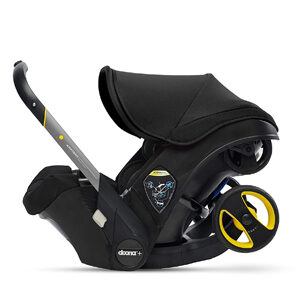
Doona Infant Car Seat and Stroller
- Weight range (lb): 4-35 (RF)
- Height limits: 32” (RF)
- Stage: 1st
- Lifespan: 6 years
Why is it better than the Chicco KeyFit 30?
- Higher height limit (+2”: 32”-30”)
- Higher weight limit (+5 lb: 35 lb - 30 lb)
- Folding design
- Four big wheels
- Combine stroller into one
- Longer age range
- Extended warranty (2 year vs 1 year)
Why its worse than the Chicco KeyFit 30?
- Costs more (+$300)
- Heavier car seat weight (+7 lbs)
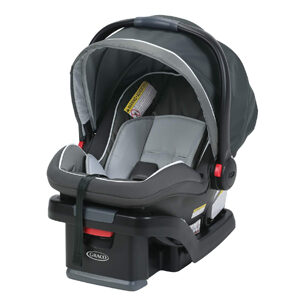
Graco SnugRide SnugLock 35
- Weight range (lb): 4-35 (RF)
- Height limits: 32” (RF)
- Stage: 1st
- Lifespan: 7 years
Why is it better than the Chicco KeyFit 30?
- Cheaper price (-$50)
- Higher height limit (+2”: 32”-30”)
- Higher weight limit (+5 lb: 35 lb - 30 lb)
- Longer lifespan (+1; 7 year - 6 year)
- Longer age range
- Lighter weight (-2 lb ;7.5 vs 9.5 lb)
Why its worse than the Chicco KeyFit 30?
- Wider for a bit tough carrying
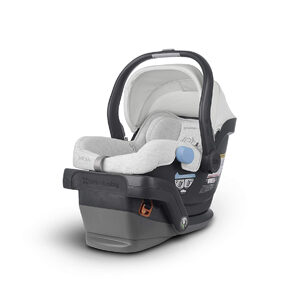
UPPAbaby MESA
- Weight range (lb): 4-35 (RF)
- Height limits: 32” (RF)
- Stage: 1st
- Lifespan: 7 years
Why is it better than the Chicco KeyFit 30?
- Higher height limit (+2”: 32”-30”)
- Higher weight limit (+5 lb: 35 lb - 30 lb)
- Longer lifespan (+1; 7 year - 6 year)
- Longer age range
Why its worse than the Chicco KeyFit 30?
- Costs more (+$100)

